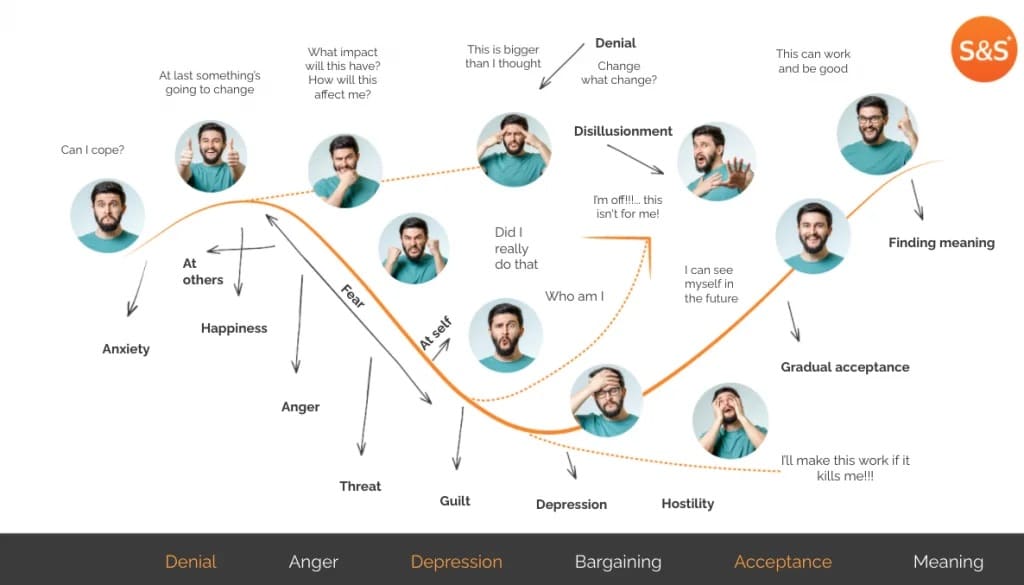Dear Leaders: Maximize your investment, nail your change management
25 May 2023
How change management is the key to the successful adoption of a platform.
What do you think of when you hear the words ‘workplace training’? Blank boardrooms? vacant stares? boring video demo’s?
Usually, the audience is disengaged within the hour and are already dreaming of what they’ll eat for lunch.
And I have to agree to some extent, training can be a neglected step in the implementation process that leads to a decision on which sandwich to buy rather than actively listening and participating in these vital few hours.
But the reality is, the investment in time and attention when adopting a new platform or system within your organization requires a clear change management process that will unlock its full potential.
Understanding change management
There’s a reason many of us are afraid to change in both our personal and professional lives – it’s hard! Why would we actively move away from the warm embrace of our comfort zones, into the icy cold wilderness of the unknown?

This is where change management comes in to help. Simply put, it is the application of a structured process and set of tools for leading the people side of change, to achieve a desired outcome.
When it comes to implementing a new CRM, the change affects multiple departments across an organization and getting early sponsorship is vital.
75% of transformation efforts fail to deliver the hoped-for results, with employee resistance a key contributing factor.
You’re asking them to leave what they know at the door and come in ready to master a new system with different nuances and steps that will change the way they operate on a daily basis. That’s why understanding the change management process and your role within it can ensure a successful change.
According to McKinsey, there are four key pillars to change management:
- Role modelling: Setting a standard that all peers will follow
- Fostering understanding and conviction: understanding what is being asked and why, the why inspires your peers to be in support of the change
- Reinforcing formal mechanisms: Show how the existing systems will support the changes being asked
- Developing talent and skills: providing your staff with the skills and opportunities to behave in the new way
Focusing on the change narrative will help your organization understand where they’re headed, why the decision was made and what good will look like once its implemented.
If that is combined with up-front, in-depth training that is done with the end users and not to them, it is much more likely to stick as they have a degree of authorship and control of the change.

Know your audience
Just before I walk into the room (both literally and virtually) to greet the group of staff I’ll be training that day, I always like to put myself in their shoes, and I think leaders in the organization should aim to do the same.
There’s always a spectrum of awareness regarding any change in an organization. At one end, you have the leaders who were heavily involved in the sales process and understand the vision of how this change will improve their organization, they know the most.
On the other end, you have the user who only found out about the change through an email (yesterday) and are coming in totally blind to this training. Everyone in the room or meeting you’re about to enter fits somewhere in that spectrum.
This level of understanding is often overlooked by executives leading the change. Research shows that people frequently overestimate the extent to which others share their own attitudes, beliefs, and opinions—a tendency known as the false-consensus effect.
Interested in more content like this? Subscribe to our newsletter 👇
There’s also the “curse of knowledge” where people find it difficult to imagine that others don’t know something they themselves know.
It’s quite easy to fall into the trap of overestimating the skill level of your audience. When you know what’s going on, connections will happen quicker, and you can easily wrap your head around the changes. Those who have no knowledge or background will struggle to make those same connections as easily, if at all, in the short to medium term.
Tailoring training and communications to your team’s skill level when adopting a new platform, will ensure you protect the significant investment you’ve made into your organization.
Explaining the “Why?”
Asking the simple three-letter word contains a significant amount of power in change management and will increase the overall success of the change.
You see, explaining the reason why a change was made is crucial for organization-wide adoption, and in most cases, it’s not communicated clearly or effectively enough.
Leadership is first responsible for introducing and then reinforcing the why. Through the sales process you understood why the change is necessary and its benefits, and so it’s up to you to champion the change to your people.
Explain why you’ve taken this path, what it will unlock for all levels of your organization, and then link this with the key attributes of the platform you’ve adopted (centralized data, richer insights, better fan engagement).
For some, the change might not impact them a great deal, but further down the line, their colleagues might have saved hours in their day through this new process or system. That is why continually linking back to the big picture will drive organizational understanding and create engaged users.
For instance, during a session with one of our recent clients we found a great balance between explaining all the features of EngageRM, how to use them effectively, and completing practice tasks. All whilst outlining why our platform was selected for their organization and how it will improve their processes – making their life easier.
Now as is the case with every session, it wasn’t all smooth sailing, but I remember hopping on my flight home knowing I left a group of engaged users who were well on the way to becoming champions of the system within their own organization.
Empowering staff to succeed
Training is a vital step in the change management process, and my job is to provide the foundation for users to become champions within their organizations. But to really drive a successful adoption of a new platform or process, leaders need to reiterate the reasons why the change was made from the beginning which sets you up for success.
For users, understanding the why and the bigger picture of this change will empower them to discover the new way of working that will ultimately create engaged, confident users who will become champions within their own teams and drive a successful change process.
Interested in more content like this? Subscribe to our newsletter 👇










